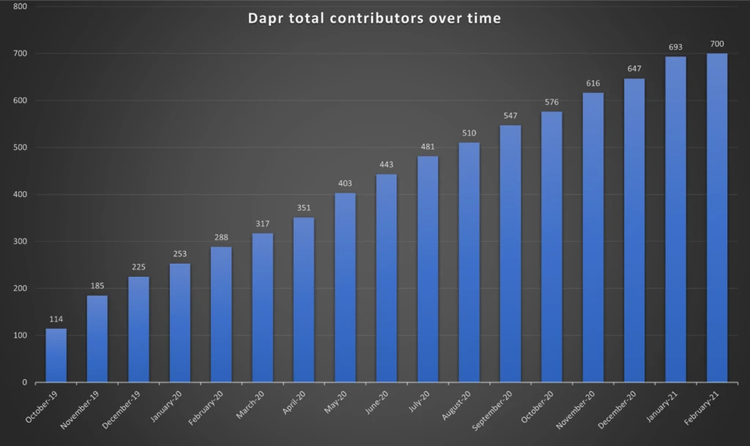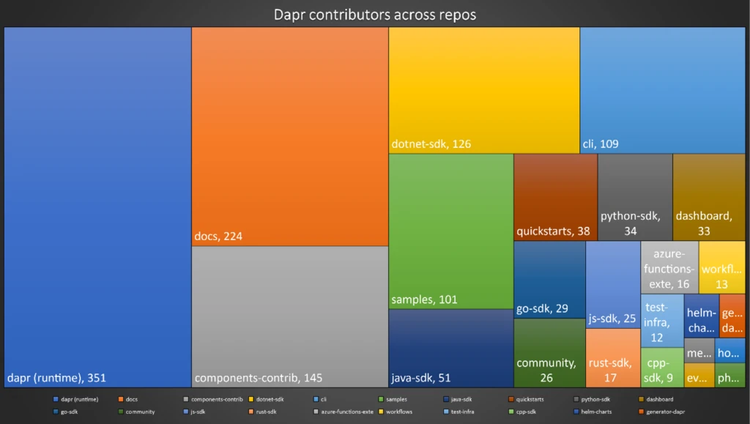
The community effort that delivered Dapr v1.0

WRITTEN BY
/en-us/opensource/blog/author/ori-zohar
Today we’ve announced the release of Dapr v1.0. The Distributed Application Runtime (Dapr) is now available as a production ready solution that helps developers build resilient, portable event-driven distributed applications on the cloud and edge.
It has been an incredible journey bringing Dapr from its initial release in October 2019 to production readiness and it could not have been made possible without a passionate, open community of developers from around the world. This is the benefit of open source—the hundreds of contributors to Dapr prove that many hands make for light work. Having many developers use Dapr, building applications in different languages and in a wide spectrum of scenarios ensures that Dapr is used and tested thoroughly. This was an important part of delivering Dapr v1.0 and will remain important as Dapr moves forward.
Since the initial announcement of Dapr, we’ve seen a rapid, steady growth of developers contributing to the project in all areas, and today we have 700 individual contributors to the project. This includes developers from cloud vendors such as Alibaba Cloud, large companies such as HashiCorp, as well as enterprises such as ZEISS who is building business critical systems with Dapr in production. Additionally, smaller startups such as Roadwork have made contributions while using Dapr to gain portability for their cloud native solution and accelerate its development for more agility.
A great example of this kind of contribution is the recent addition of the Dapr PHP SDK. This SDK was contributed by a developer from Automattic who is both passionate about PHP and excited about the possibilities Dapr holds. Contributions go beyond code and come in the form of docs, samples, issues, and guidance to Dapr users like the one provided by New Relic on how Dapr observability can be used with their monitoring tools.


As illustrated above, contributors have been making an impact in all corners of the Dapr project. Noticeably, the areas that have seen contributions from the greatest number of community members are the core areas of Dapr—the Dapr runtime, which includes the code of the Dapr sidecar, the docs, and the components-contrib, the repository holding the code for components.
Having many contributors build new components is especially valuable, as components offer Dapr users the ability to leverage the Dapr API and interface with a wide range of technologies and systems. Having a large number of components available means helping even more developers simplify and accelerate the process of writing distributed applications. More components also means more flexibility in where these applications can be deployed, making code even more portable in multi-cloud or hybrid scenarios.
Today Dapr offers over 70 different components for state management (such as Redis, MySQL, Azure Cosmos DB, and many more), Pub/Sub messaging (such as RabbitMQ, AWS SNS/SQS, and Kafka), secret stores (such as Kubernetes secret store, Azure Key Vault, and HahiCorp Vault) and both input and output bindings to integrate with services such as SendGrid, Azure Events Hub, and more.
Building an inclusive, open community has always been a high priority for the Dapr project. Last September, we shared the open governance model Dapr follows. We are committed to keeping Dapr vendor-neutral and welcoming to all developers and community members. To this end, we have begun evaluating open-source software foundations for Dapr’s home in the future.
We invite you to try Dapr yourself and join the community. We believe that Dapr can help you build distributed applications more easily and we are always looking for more developers to provide feedback, open issues, and help us define the future of Dapr.
Learn more about Dapr
- Get started with Dapr
- Explore the Dapr documentation
- Learn more about Dapr v1.0
Join the Dapr community
- Join the community on Discord
- Join the Dapr community calls and watch recordings of past calls
- Follow @daprdev on Twitter
